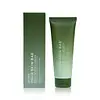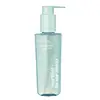What's inside
What's inside
 Key Ingredients
Key Ingredients

No key ingredients
 Benefits
Benefits

 Concerns
Concerns

 Ingredients Side-by-side
Ingredients Side-by-side

Water
Skin ConditioningGlycerin
HumectantButylene Glycol
HumectantAcrylates Copolymer
Sodium Cocoamphoacetate
CleansingCocamidopropyl Betaine
CleansingSodium Cocoyl Glycinate
CleansingSodium Chloride
MaskingSpirulina Platensis Extract
Skin ProtectingPropanediol
SolventHamamelis Virginiana Leaf Extract
Skin ConditioningGlycolic Acid
Buffering1,2-Hexanediol
Skin ConditioningSodium Hydroxide
BufferingXanthan Gum
EmulsifyingCoconut Acid
CleansingSodium Cocoate
CleansingTetrasodium EDTA
Caprylhydroxamic Acid
Water, Glycerin, Butylene Glycol, Acrylates Copolymer, Sodium Cocoamphoacetate, Cocamidopropyl Betaine, Sodium Cocoyl Glycinate, Sodium Chloride, Spirulina Platensis Extract, Propanediol, Hamamelis Virginiana Leaf Extract, Glycolic Acid, 1,2-Hexanediol, Sodium Hydroxide, Xanthan Gum, Coconut Acid, Sodium Cocoate, Tetrasodium EDTA, Caprylhydroxamic Acid
Water
Skin ConditioningGlycerin
HumectantCocamidopropyl Betaine
CleansingPropanediol
SolventHydroxypropyl Bis-Hydroxyethyldimonium Chloride
HumectantSodium Methyl Cocoyl Taurate
CleansingSodium Benzoate
MaskingPanthenol
Skin ConditioningTrehalose
HumectantAcrylates/C10-30 Alkyl Acrylate Crosspolymer
Emulsion StabilisingXanthan Gum
EmulsifyingSodium Chloride
MaskingSaccharide Isomerate
HumectantAllantoin
Skin ConditioningPolyquaternium-39
Chlorphenesin
AntimicrobialGlyceryl Polyacrylate
Potassium Hydroxide
BufferingDisodium EDTA
Butylene Glycol
HumectantBetaine
HumectantSodium PCA
HumectantCitric Acid
BufferingSodium Citrate
BufferingSodium Lactate
BufferingPCA
HumectantHouttuynia Cordata Extract
Skin ConditioningSerine
MaskingAlanine
MaskingGlycine
BufferingGlutamic Acid
HumectantLysine Hcl
Skin ConditioningThreonine
Arginine
MaskingPentylene Glycol
Skin ConditioningBeta-Glucan
Skin ConditioningCaprylyl Glycol
EmollientProline
Skin ConditioningWater, Glycerin, Cocamidopropyl Betaine, Propanediol, Hydroxypropyl Bis-Hydroxyethyldimonium Chloride, Sodium Methyl Cocoyl Taurate, Sodium Benzoate, Panthenol, Trehalose, Acrylates/C10-30 Alkyl Acrylate Crosspolymer, Xanthan Gum, Sodium Chloride, Saccharide Isomerate, Allantoin, Polyquaternium-39, Chlorphenesin, Glyceryl Polyacrylate, Potassium Hydroxide, Disodium EDTA, Butylene Glycol, Betaine, Sodium PCA, Citric Acid, Sodium Citrate, Sodium Lactate, PCA, Houttuynia Cordata Extract, Serine, Alanine, Glycine, Glutamic Acid, Lysine Hcl, Threonine, Arginine, Pentylene Glycol, Beta-Glucan, Caprylyl Glycol, Proline
Ingredients Explained
These ingredients are found in both products.
Ingredients higher up in an ingredient list are typically present in a larger amount.
Butylene Glycol (or BG) is used within cosmetic products for a few different reasons:
Overall, Butylene Glycol is a safe and well-rounded ingredient that works well with other ingredients.
Though this ingredient works well with most skin types, some people with sensitive skin may experience a reaction such as allergic rashes, closed comedones, or itchiness.
Learn more about Butylene GlycolCocamidopropyl Betaine is a fatty acid created by mixing similar compounds in coconut oil and dimethylaminopropylamine, a compound with two amino groups.
This ingredient is a surfactant and cleanser. It helps gather the dirt, pollutants, and other impurities in your skin to be washed away. It also helps thicken a product and make the texture more creamy.
Being created from coconut oil means Cocamidopropyl Betaine is hydrating for the skin.
While Cocamidopropyl Betaine was believed to be an allergen, a study from 2012 disproved this. It found two compounds in unpure Cocamidopropyl Betaine to be the irritants: aminoamide and 3-dimethylaminopropylamine. High-grade and pure Cocamidopropyl Betaine did not induce allergic reactions during this study.
Learn more about Cocamidopropyl BetaineGlycerin is already naturally found in your skin. It helps moisturize and protect your skin.
A study from 2016 found glycerin to be more effective as a humectant than AHAs and hyaluronic acid.
As a humectant, it helps the skin stay hydrated by pulling moisture to your skin. The low molecular weight of glycerin allows it to pull moisture into the deeper layers of your skin.
Hydrated skin improves your skin barrier; Your skin barrier helps protect against irritants and bacteria.
Glycerin has also been found to have antimicrobial and antiviral properties. Due to these properties, glycerin is often used in wound and burn treatments.
In cosmetics, glycerin is usually derived from plants such as soybean or palm. However, it can also be sourced from animals, such as tallow or animal fat.
This ingredient is organic, colorless, odorless, and non-toxic.
Glycerin is the name for this ingredient in American English. British English uses Glycerol/Glycerine.
Learn more about GlycerinPropanediol is an all-star ingredient. It softens, hydrates, and smooths the skin.
It’s often used to:
Propanediol is not likely to cause sensitivity and considered safe to use. It is derived from corn or petroleum with a clear color and no scent.
Learn more about PropanediolChances are, you eat sodium chloride every day. Sodium Chloride is also known as table salt.
This ingredient has many purposes in skincare: thickener, emulsifier, and exfoliator.
You'll most likely find this ingredient in cleansers where it is used to create a gel-like texture. As an emulsifier, it also prevents ingredients from separating.
There is much debate on whether this ingredient is comedogenic. The short answer - comedogenic ratings don't tell the whole story. Learn more about comegodenic ratings here.
The concensus about this ingredient causing acne seems to be divided. Research is needed to understand if this ingredient does cause acne.
Scrubs may use salt as the primary exfoliating ingredient.
Learn more about Sodium ChlorideWater. It's the most common cosmetic ingredient of all. You'll usually see it at the top of ingredient lists, meaning that it makes up the largest part of the product.
So why is it so popular? Water most often acts as a solvent - this means that it helps dissolve other ingredients into the formulation.
You'll also recognize water as that liquid we all need to stay alive. If you see this, drink a glass of water. Stay hydrated!
Learn more about WaterXanthan gum is used as a stabilizer and thickener within cosmetic products. It helps give products a sticky, thick feeling - preventing them from being too runny.
On the technical side of things, xanthan gum is a polysaccharide - a combination consisting of multiple sugar molecules bonded together.
Xanthan gum is a pretty common and great ingredient. It is a natural, non-toxic, non-irritating ingredient that is also commonly used in food products.
Learn more about Xanthan Gum